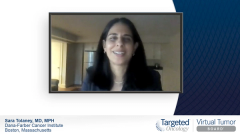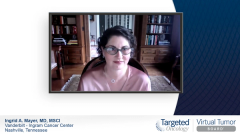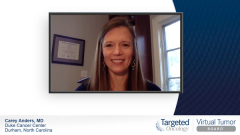
Case 1: Novel Therapeutic Approaches in High-Risk, Early Stage HER2+ Breast Cancer
Experts in the management of breast cancer review some trials leading to the future of personalized treatment for HER2+ breast cancer.
Episodes in this series

Sara Tolaney, MD, MPH: There’s certainly the ability to continue to adapt our treatment based on risk and based on response to preoperative therapy, now with T-DM1 [trastuzumab emtansine], and then the consideration of neratinib in the patients who are high risk, hormone receptor-positive. It’s also teaching us that we can tailor treatment even further as we develop better and better HER2-directed therapies. Andy, could you tell us about your thinking here and where we’re headed in terms of trying to personalize treatment in this HER2-directed space?
Andrew Seidman, MD: I’m not going to take the credit for this being my thinking. I’m going to let everybody know about a very important trial called CompassHER2-pCR, which offers the potential to avoid both anthracycline and carboplatin. I want to nickname this the “let’s get rid of carboplatin” trial. But patients get weekly paclitaxel with trastuzumab and pertuzumab preoperatively, and those patients who have a pathCR [pathologic complete response] can simply continue the dual antibodies. We’ll see what their downstream outcomes are to determine whether this is OK. If it is OK, it’s going to allow us to move away not only from anthracycline, but from carboplatin. And those non-pCR [pathologic complete response] patients can get treated at the discretion of their physician. There, certainly the obvious use of the ADC [antibody-drug conjugate] T-DM1 [trastuzumab emtansine], and some physicians may feel the compulsion to give anthracycline in the postoperative setting. Using pCR as our compass to navigate what to do postoperatively is the theme of that trial. For those of you listening, if you have access to it, I encourage you to strongly consider this for your patients.
Sara Tolaney, MD, MPH: It’s critical how it offers the opportunity to deescalate therapy, and then adapt adjuvant treatment in those pCR patients to just get biologic treatment and spare people further chemotherapy than just a taxane, which is wonderful because we’re getting better and better with our HER2-directed treatment. Adapting based on response can allow us to figure out who can do less. The other arm of that trial that’s also interesting is taking the opposite approach, trying to escalate for those people who don’t do as well. People for example who have residual disease, can we add on tucatinib to T-DM1 [trastuzumab emtansine] and improve upon KATHERINE even further? Not only in terms of improving disease-free survival, but potentially even reducing CNS [central nervous system] recurrence. With these HER2 TKIs [tyrosine kinase inhibitors] as we discussed earlier, maybe that is a potential. There are certainly other approaches being taken in this adaptive space. I don’t know if Carey or Ingrid, do you want to comment on some other approaches outside of CompassHER2-pCR that are being explored here?
Carey Anders, MD: Another pathway to consider is the estrogen receptor [ER] pathway. Many of us have felt inclined to consider CDK4/6 inhibition in combination with HER2-directed therapy. I know it’s a bit beyond the scope of this conversation today, but that space has been complex in the ER-positive HER2-negative space. But we do know there is some crosstalk between ER and HER2, and it’ll be very interesting. The monarcHER study will be evaluating this question. In patients with residual disease, high-risk ER-positive, HER2-positive, should we be considering CDK4/6 inhibition?
Ingrid A. Mayer, MD, MSCI: It’s an interesting study because if people remember the early data on CDK4/6 inhibition, the classic slide that people showed, the cell lines that responded to CDK4/6 inhibitors. We can’t forget that these drugs are very active in HER2 disease as well, not just ER. It’s not just the crosstalk between the ER and the HER2 signaling pathways, but also the dual activity that CDK4/6 inhibition may have on both pathways. It would definitely be interesting.
The other trial that comes to mind that is interesting as well, shying away from the ER/PR [estrogen receptor, progesterone receptor] or brain metastasis story, is a trial exploring different antibody conjugates. Right now based on the KATHERINE trial, for patients with residual disease, high risk, even though this was again done in an era before pertuzumab, we are now using T-DM1 [trastuzumab emtansine] as a standard of care, 14 doses in people with residual stuff, just like this patient in case 1 would get. But since then, there are several antibody conjugates now that are coming into the standard-of-care world beyond T-DM1 [trastuzumab emtansine]. One that has been recently approved for metastatic setting is the one called trastuzumab deruxtecan, as you all know. There is a study, the DESTINY-Breast05, that is comparing T-DM1 [trastuzumab emtansine] with trastuzumab deruxtecan in that setting. We’ll see. It is clearly an incredibly active drug in terms of responses and PFS [progression-free survival], at least in preliminary data. The phase 3 data in the metastatic setting are not available yet. But it does worry me a little that now we’re using this drug in curable people, and the drug has a 13% rate of interstitial lung disease [ILD]. There’s that to contend with. As we get a little smarter in detecting that early, I think the rates of ILD will be the same, but maybe not grade 3 or grade 2, where people are going to recognize that a little earlier. It may not be that big of a deal, and we won’t see deaths from it. But that’s cautionary, and I would love to see the very long-term data on that trial to be comfortable switching from T-DM1 [trastuzumab emtansine] to deruxtecan if the trial should be positive. Then if that trial is positive and CompassHER2 RD is positive, we’ll know what to do.
Sara Tolaney, MD, MPH: This brings us to our quandary in the metastatic setting where we also have multiple options and are trying to make choices. But it’s nice to see all these trials that are trying to personalize care for HER2-positive patients, and hopefully decrease toxicity while at least maintaining if not improving upon efficacy, which is so important.
Transcript edited for clarity.














































